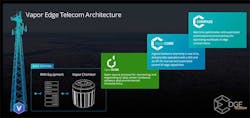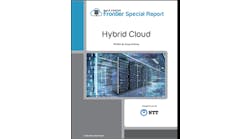As new technologies drive the need for edge computing, where will this distributed compute and storage infrastructure reside? Vapor IO believes the best approach is to place micro data centers at the base of existing wireless towers.
Vapor IO has launched Vapor Edge for Telecom, a platform to enable rapid deployment of edge capacity by wireless network operators and real estate investment trusts (REIT) specializing in the telecom tower business.
“Mobile operators and landowners are in an ideal position to capitalize on the emerging need for low-latency edge-computing,” said Cole Crawford, CEO and founder of Vapor IO. “They own the key infrastructure, including tens of thousands of remote tower and base station locations with power and high bandwidth backhaul.”
Extending Their Edge
The telecom offering is a refinement of Vapor Edge, a software suite to provide “lights out” management of data and facilities, along with tight integration with cloud platforms.
Vapor has focused on the nascent market for edge computing, which moves content closer to users, improving the experience for streaming video and gaming. It’s a trend that has huge implications for Internet infrastructure, which traditionally has been focused on major markets.
Vapor’s software moves content across a distributed network to improve latency, shifting assets closer to the user when needed. It aims to eliminate the need for on-site staff, and eliminate the need for expensive backup equipment like generators or centralized UPS systems.[clickToTweet tweet=”Vapor IO’s Cole Crawford: Mobile operators & landowners are in an ideal position to capitalize on edge-computing.” quote=”Vapor IO’s Cole Crawford: Mobile operators & landowners are in an ideal position to capitalize on edge-computing.”]
Vapor has also developed a unique circular enclosure that can house six racks of data center equipment. In the event of a power outage, the on-board batteries included in the Vapor Chamber can keep the IT assets online while data is backed up to a cloud platform or data center.
A Cloud Play for Carriers, Tower REITs
Vapor Edge for Telecom is designed to make it easy for carriers and wireless base-station landowners to offer cloud compute capabilities. Crawford believes this can create new business models for the wireless operators and REITs, enabling them to forge partnerships to deliver edge capacity to public cloud providers, web-scale companies, and “over the top” content providers.
Housing micro data centers at the base of telecom towers could also make it easier for carriers upgrade their networks with rack-mountable equipment, including off-the-shelf servers to virtualize networks using NFV (Network Function Virtualization).
“Vapor Edge can help carriers upgrade their infrastructure and business models as they move to a fully virtualized infrastructure with edge computing and 5G capabilities,” said Crawford.
Crawford says the combination of Vapor Edge software and the Vapor Chamber can slash the cost of data center construction, improving the economics of deploying capacity in remote locations.
Vapor Edge consists of both software and hardware designs that Vapor IO licenses to partners. Here’s an overview:
- Vapor CORE software can remotely monitor and administer data center environments. It tracks centralized data center and edge machines, ingests hardware telemetry in real time, and provides tools to remotely view and manage their edge operations.
- Vapor Compass software creates automated command-and-control policies for managing workloads in distributed edge environments. Compass is designed to make real-time optimization decisions, including rescheduling workloads onto edge nodes or centralized data centers, based on policies, including latency and cost.
- The Vapor Chamber circular racking system is tightly integrated with Vapor Edge software, and ideal for use in cell towers or rooftops.
Each Vapor Chamber can support six racks positioned in a ring. Cool air enters from the exterior, and waste heat is contained in a central vertical column, allowing airflow to be managed with minimal use of fans. The enclosure features an on-board battery, modular rectifiers, and fire suppression. It doesn’t require a raised floor environment or room-level coolig, but can live outdoors and operate in extended heat and humidity ranges.
Vapor Chamber as Key Building Block
For telecom deployments, the Vapor Chamber has been enhanced with seismic reinforcement and additional RF shielding.
The Vapor Chamber enclosure from Vapor IO houses six racks in a round enclosure with a central “hot aisle.” (Photo: Vapor IO)
“The Vapor Chamber for Telecom is designed to be deployed deep in the field using base station enclosures that are often, literally, at the base of the antenna and in the vicinity of high-powered RF devices (hence the need for an advanced RF shielding option),” said Crawford. “This can be an existing facility or a modular enclosure such as those offered by BASELAYER or other modular providers.”
Early deployments are likely to be used to boost density in existing markets, rather than remote locations.
“We’re seeing most of the initial interest from operators who want to offer ultra-low-latency compute and increased capacity in existing urban areas,” said Crawford. “Operators are looking to leverage their infrastructure to tap into the new edge-related revenue streams coming from new applications, such as autonomous driving, augmented and virtual reality, and IoT.”
Opportunity for Tower REITs?
The Edge for Telecom offering could be an intriguing play for tower REITs, which include American Tower, Crown Castle, and SPG Communications. These companies own the towers, and in some cases the land beneath them, and lease space to telecom and wireless providers.
“Landowners see Vapor Edge for Telecom as a way to maximize the value of their leasable space; whereas the wireless operators see it as a way to upgrade their network, tap into revenues higher up in the stack, and deliver new services to their subscribers,” said Crawford.
“What happened with enterprise IT is now happening with the mobile operators,” said Crawford. “As these companies are increasingly focused on commoditizing the base station and moving logic and functionality into rack infrastructure they will face the same build versus buy decision tree that the enterprise went through years ago.
“The enterprise ultimately decided that building and managing data centers was not core to their business and so started adopting cloud where possible. We think the telco / mobile operators will ultimately come to the same conclusion and we’re here to make that decision easy.”
Explore the evolving world of edge computing further through Data Center Frontier’s special report series and ongoing coverage.






